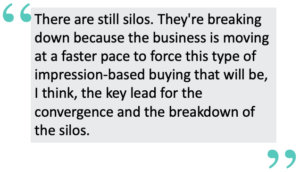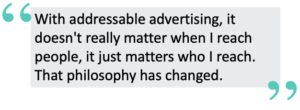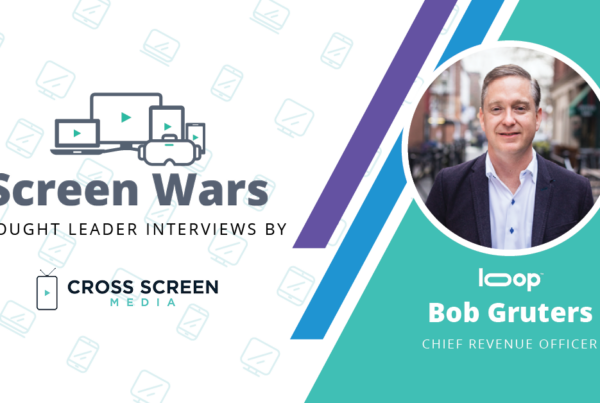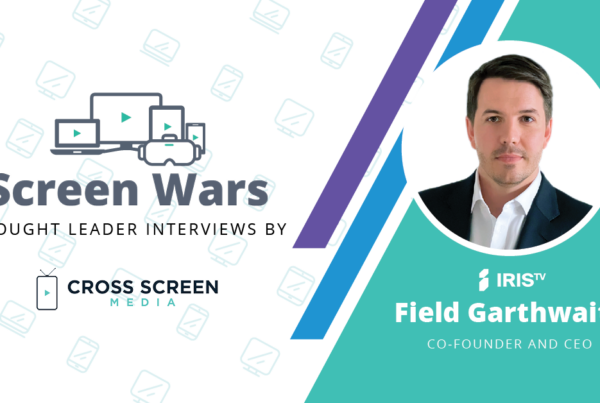Magnite’s Adam Lowy joins Cross Screen Media CEO Michael Beach to share his expertise on the major industry shifts and opportunities for players across the Convergent TV space in our latest Screen Wars Thought Leader Interview. Full transcript below.
Michael Beach: Welcome to another edition of Screen Wars. Today, we’re honored to have Adam Lowy, who is the Head of North American Demand Sales and Strategy at Magnite. Previous to that, Adam served as the Chief Commercial Officer at Telaria, and has done extensive stints at other companies such as Sling TV and Canoe Ventures. Welcome, Adam.
Adam Lowy: Thanks, Michael. Thanks for having me.
MB: We’ll start off with a little bit of an icebreaker we’ve asked everybody. What was your first job, and what lessons did you take away from it that you applied to your career?
AL: I appreciate the question. I actually started in the control room. I was at a small cable TV network called Newstalk Television, or what was called the Talk Channel. And I was an associate director, working the control room, calling camera shots, working on timing in terms of how long the show runs, and basically timing it out for the director in terms of when we go to break, when we’re on the show, what camera angles, talking to the talent through their IFB or their earpieces. But really, I was a control room guy working on the speed and pace of the business, working on quick decisions, and really just putting TV shows together. Totally different to where I am now, but I think what was really neat about it is it gave me a whole perspective, a well-rounded perspective, of how TV is handled, how it’s done, how TV shows are made, shot, working with producers, etc.
MB: What do you think that’d be like doing that remote today?
AL: I think it would be pretty interesting remotely today. It’d be interesting with the delay, but I don’t know how producers are doing right now. It’s slowly getting back into shape.
MB: How did you get your start in the Convergent TV space?
AL: I have been working on new businesses, new advanced TV businesses, for quite a while at Canoe Ventures, as well as CBS, actually, years ago at CBS Distribution, where I was working on brand entertainment, a new business, how to look at advertising in a different way. And that’s how convergence came in. When I got to Canoe, I was working on dynamic ad insertion and then went to Dish working on addressable advertising, working on interactive television and advanced TV, and then that morphed into Sling TV and advertising sales and dynamic ad insertion in a different way. But all that put together is converging buying and converging the philosophy of how advertisers buy television shows and content.
I was an ops guy early on, as I said, into working in the control room, but also in operations as well, at ABC, and just putting it all together in how things work and how things are bought and sold. It just got me into converging it from TV into digital. It was a great interest of mine of being that change agent in the industry where many of us are. That’s super exciting to me. I don’t like the norm. I like doing things differently and looking at things not where we are today but where are we going and helping to lead that. And that’s how I really was doing convergence.
MB: You certainly have obviously been at multiple trailblazers that are precursors to what’s just the norm today. Everyone’s talking about addressable advertising today, but probably not back at Dish or Canoe as much as today.
AL: Nowhere near today. Looking back at Canoe, Michael, it was really one of the few focuses of the company, along with dynamic ad insertion, addressable was really one of the focuses, and it was so early on, and it was really just that there’s no way this was going to be able to get done. And then at Dish, we started to really work on addressable. Because you were a direct to home service with satellite, it just started to come together. It makes a whole heck of a lot of sense. It’s basically digital advertising in TV. And then, as it started to scale up, and as CTV, and OTT, and Sling working on that as well, just impression-based buying and that philosophy of putting data behind it and making an audience based buy just really took off. So, it’s becoming bigger and bigger than ever. And I think audience-based buying mixed with contextual buying is really where we are now and what connected TV or OTT offers with the one-to-one, impression-based buying philosophy that’s feeding the business.
MB: Before we dig in any further, would you mind giving our community a little background where Magnite sits in the convergent TV space?
AL: Magnite is the largest omni-channel sell-side platform. We’re a global company. And what we do and what we focus on so well is really putting TV convergence together. With Telaria, which Magnite merged with quite a few months ago in April, we are basically the leaders in the connected TV space from Telaria, as well as the leaders in the omni-channel space with Rubicon Project, which was previously the name of the company. But we focus in on programmatic. We focus in on automation and moving the business forward in automated buying and being able to serve impressions across all platforms.
We call it omni-channel and connected TV through our platforms, and that’s where the future we believe is, Michael, where an advertiser could come to us and we could be a one-stop shop for them. And with our top tier premium publishers that we work with, and we work with the best ones out there, in terms of Hulu, and Sling, and Disney, and Turner etc., that we can go ahead and find the audience that they need in impression-based buying philosophy through programmatic and really helping to secure buying, in terms of automated buying, where we believe the future is.
MB: Do you still see siloed video buying teams? And if so, what’s the best entry point for your organization?
AL: Siloed buying teams are something that we’ve been seeing for quite a while. And being into the day to day, working on the demand side now more than ever, that’s really one of the things that we’re trying to help our agency and holding company partners to really break down those silos. What we’re seeing is there is still the TV side of the house and the digital side of the house.
And in terms of connected TV, and OTT, and the video buying philosophy, the digital folks are fine. They’re in it. They know how to buy CTV, and OTT, and impression-based buying. The TV side of the house that’s been buying on GRPs and more of that math game, this has kind of been a whirlwind for them to get into connected TV, and OTT, and video because it really converts everything into, essentially, impression-based buying.
So more agencies that we work with are starting to look holistically. What I’ve seen over the past few years is there’s generally an advanced TV team, or there are a few folks that are responsible to help the convergence of the company, where the TV folks will work with the digital folks to understand impression-based buying, whether it’s addressable, or other means that’ll get the silos broken down at the holding companies. But what I think is also happening is the publishers are integrating. Fox owns Tubi and ViacomCBS owns Pluto. As that’s growing, that’s forcing both sides to work together on a larger scale on the channel type of buying, which therefore gets the TV side and the digital side of the house having to work together and looking holistically as an entire buy. So said differently, there are still silos. They’re breaking down because the business is moving at a faster pace to force this type of impression-based buying that will be, I think, the key lead for the convergence and the breakdown of the silos. 
MB: Many have said that in the last six months, we’ve had five to ten years of digital transformation packed into that time in areas such as shift to streaming. Do you agree? And if yes, do you think this is a short term shift, or are we going to go back to the old normal and just slowly grow from there?
AL: From an inventory perspective, in connected TV and OTT, we have not even scratched the surface. And what I mean by that is a few things are starting to happen. Number one, you have new players entering the space, and these are the big guys. So you’ve got Peacock entering the space. You’ll have HBO coming in with commercials in the start of the year. You’ve got Disney with bigger initiatives with Hulu and Disney+. But the entire growth of the businesses is happening, that’s number one.
Add to that, dynamic ad insertion hasn’t even really scratched the surface of where it can be. Because right now, most of the play on the publishers is in what we call the local time or the operators time. So roughly two minutes an hour is where the ad insertion is happening. The bigger chunk, the 14-15 minutes of network time, very little of that is actually being dynamically inserted, and thus being converged or done through digital buys. A lot of it is still TV buying with the measurement being dragged over and essentially just being added onto the TV by measurement.
Once that changes, or once dynamic ad insertion comes into play, and you see a bigger shift, which is really starting to happen at a faster pace, of more viewers into CTT/OTT, where that change is going to happen in the buy, where I no longer need to get the TV credit, and I could get just as much money or more going into digital impression based buy, that’ll completely blow up and grow the advertising space more than we’ve ever seen. That’ll be the bigger chip away of the $70 billion TV money, is again because of the Nielsen TV credit starting to move over to digital. That’s a big one.
Additionally, with that, I would say that the digital buying atmosphere, technology, the underpinnings, I like to say, of CTV/OTT allows proof of purchase, allows better means for attribution, we’ll start to see more e-commerce. We’ll start to see more of essentially how the performance-based buying is. That philosophy of “Did my ad work? What did I get from it?” as opposed to just something a few weeks later, when you’ll know that you hit a certain amount of eyeballs.
Couple that with addressable and finding the audience you reach, and that’s just going to move everything at a much faster pace. I believe you’ll see some swing back over to the TV side when COVID calms down a little bit, but it’ll never be where I think the business ever was, and that $70 billion will continue to chip away into more digital buying as these things I started to mention start to creep into the buying phenomenon.
MB: You might have answered this in that group, but what’s the biggest change you’ve seen in the video ad marketplace, and how has your company adapted to that?
AL: There have been quite a few things. Obviously, the size and the scope of the business. But viewing patterns are starting to really change with people home, and looking at live and on-demand television, and then of course the overall growth. But we’ve talked about how prime time isn’t really prime time anymore. We’re certainly seeing that. So it’s really throwing away how you’re looking at data and how you’re looking at where consumers are and when advertisers want to reach them. But to that point, with addressable advertising, it doesn’t really matter when I reach people, it just matters who I reach. That philosophy has changed.
Additionally, every dollar counts. And that is always a fact, but I think now more than ever, just given the environment we’re in and in terms of the buying power and the process in digital, I think there’s more scrutiny, and more data analysts, and more looking at your buys and seeing, “Is it efficient? Is it right? Is there less waste?” Because essentially, addressable advertising one-to-one is about eliminating waste. And really, that scrutiny of buying has changed more than ever, and will probably continue as we move on. That may be something that’s interesting, if the pendulum does swing more to TV buying, where the TV buyers start. That philosophy is really going to change in terms of the efficiency of their buys, just because they start to get their feet wet more in the digital side of the house.
MB: Looking ahead, which future development are you most excited about in the Convergent TV space?
AL: First of all, it’s something I mentioned before, about the growth of dynamic ad insertion. That’s a big one. Attribution is something that I am laser focused on. And being able to prove your buy, not just that I reached who I wanted to reach, but also now that the buy actually worked and something happened. There was an action. There was a purchase. That is incredibly exciting.
And the consolidation part. Again, you’ve got the big players now in the space. They have a lot of money to market. They’re focusing now on CTV and OTT being a mainstream part of the business. And that just brings an overall entire growth of companies to connected TV and OTT. So that just brings up more innovation and the next level of where CTV/OTT is going to go.
So those are the few things off the top of my head. But additionally, with that, programmatic. We’re seeing our partners now, where it was 40-50% of their business was programmatic. And fast forward a month, or two, or three later, and now it’s 60%, some have 70% of their advertising business as programmatic. Growth is really going through the roof, and that’s for multiple reasons. Obviously, impression-based buying, addressable, the speed, the efficiency, and just how quickly the business is moving up, and less really of the upfront buying process and more into the scatter, buy now, air now type of philosophy.
There’s definitely more discussions and richer discussions now of upfront philosophies or upfront buying behavior going into programmatic. And that’s exciting too. So automation just brings up a whole new philosophy and trend that I’m very excited to see as we go on, especially into live sports and more event type programming, because it brings up a whole new dynamic.
MB: I’m sure you’ve seen huge growth in both demand per advertiser, but also just the number of advertisers in general. When you look at Facebook with 8 million advertisers and traditional TV with less than a hundred thousand, there’s obviously a ton of room to grow, that if you can get anywhere near even half a million advertisers, that amount of demand could really take off for programmatic.
AL: So true. You’re absolutely right. We look at our platform, and what we’re seeing, it’s more advertisers getting into connected TV and OTT, more companies that have folks that are focused in on connected TV, are specialists in programmatic and CTV/OTT. As well as, now, obviously, political. Huge. Brings a whole new aspect to CTV/OTT buying and programmatic, as well as the direct consumer business, the performance-based, or DR business, is now shifting over more from TV buying into connected TV.
A year or two ago, it was the auto, the telecom, some CPG, but now everybody is getting in because the eyeballs are there, and they have to get into the space. And to your point, the amount of advertisers is just growing, which is bringing more bid density into programmatic auctions, and it’s bringing more different opportunities into buying. So it’s really starting to take off. And as I’ve been saying for a while, connected TV is really becoming mainstream now.
MB: Absolutely. One more question. Given the environment, if you could get your whole team to read one book, what would that book be?
AL: That’s a really good question. Wow. That involves reading. I am a big fan of reading about coaching sports in general. If you read Bill Belichick’s book about how to look at a team, how to grow a team, how to start and really look at the specifics. It was a biography on Bill Belichick that I actually finished a couple months ago. How to start small and scale up as a business is one thing. But how he’s looking at his team is different sectors or different groups, the receivers, the running backs, and then how to work in harmony and together, which is so much about business, but also in a growing, scaling, exciting, fast-paced business that we’re in right now, how we can all work together and get everybody on the same page. And that’s why I like reading about coaches. And I think Belichick is a good one. Pat Riley is another one, and Calipari, just learning how they lead teams.
MB: Do you think Belichick is going to win another one without Brady?
AL: I hope not. Not a fan. More of a Giants fan, but that’s a tough one, too.
MB: It’s going to be fascinating. Well, we’re grateful for your time, and I’m sure our community is going to really love this talk. Thank you for joining us today.
AL: Of course. Thank you, Michael. I appreciate the opportunity.
See the rest of the Screen Wars Thought Leader Interview series here!
Adam Lowy is Head of North American Demand Sales and Strategy at Magnite. Mr. Lowy joined Telaria from DISH Network where he was responsible for the monetization of Sling TV, DISH Anywhere, advanced television products, and accelerating the convergence of TV and digital advertising. He was the architect and leader of Sling TV’s ad sales platform including revenue, strategy, partnerships and launching live linear television’s first dynamic ad insertion (DAI) platform including programmatic real-time auctions, cross platform addressable advertising and measurement. Prior to DISH, Mr. Lowy held multiple positions at Canoe Ventures, the cable industry consortium dedicated to progress the spread of advanced television capabilities. Prior to that, Mr. Lowy was Vice President of Branded Entertainment & Online Integration at CBS Television Distribution, as well as a Director of Affiliate Relations and General Manager of Program Operations at the ABC Television Network.
Cross Screen Media is a marketing analytics and software company empowering marketers to plan, activate, and measure Connected TV and audience-driven Linear TV advertising at the local level. Our closed-loop solutions help brands, agencies, and networks succeed in the Convergent TV space. For more information, visit CrossScreenMedia.com.




